Excavating a soil pit is to peel back the only layer of the Earth we know, to see what lies beneath. Soil pits are a way of traveling back in time, to see what the soil looked like before plants and time took hold.
However, there are many ways to dig a soil, each with their own advantage and disadvantage.
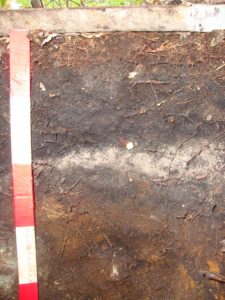
A typical soil profile (Typic Haplorthod in New Hampshire).
The most basic goal of a soil profile face is to expose the different horizons for analysis. A soil pit allows for determination of a whole spectrum of soil properties: horizon depths, colors, texture, structure, root density, rock fraction, etc… for a soil profile. This is the tried and true method, for amateur soil aficionado to the veteran pedologist. However, this can be very difficult or easy to dig.
Digging an entire soil profile can be tough in soils with high rock content and nearly impossible in soils with strong restricting layers from cementation by clays, carbonates, or silica.
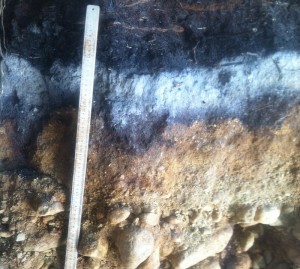
The high rock fraction at the bottom of this soil pit was extremely difficult to dig through!
However, soils that have weak structure, low clay content, and have few tree roots are easy to dig in.
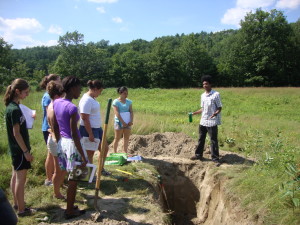
This soil pit was dug by two people in 3 hours because it was very sandy with little structure.
One of the next important things to think about when excavating a soil pit is figuring out how it will be analyzed. Many scientists choose to excavate soil pits based upon predetermined depth intervals. By choosing depth increments rather than by horizons and the innate structure of the soil, scientists often miss the unique features of each horizon. Granted, it is far more easier for calculations at the landscape and global scale to assume soils are homogeneous and use depth intervals. However as shown in the illustration below, important features are missed.
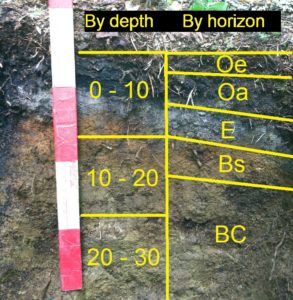
Analyzing a soil pit by depth increments rather than by horizon. Notice how very different horizons can be lumped together.
Lastly, soil pits should be dug based upon their intent. If the goal is to sample a soil profile to bedrock, make sure you dig it wide enough. A general rule is for every foot in depth, it should be one foot wide and one foot in horizontal dimension. If you don’t follow this rough rule, you might end up eating and wearing a lot of soil!
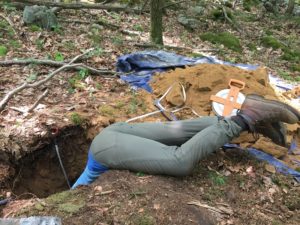
If you don’t make the soil pit big enough, you’ll have to do some acrobatics to collect your samples!
If the ultimate goal of a project is to scale results to the landscape or global scale, then digging quantitative soil pits is the best method. It can adequately assess soil, root, and rock mass in a given volume when done correctly. They can be excavated multiple times on the small scale (15 cm by 15 cm) or a few on a larger scale (50 cm x 50 cm).
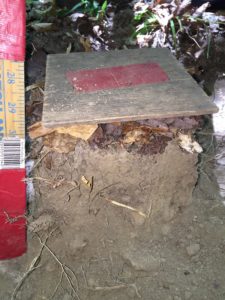
Small quantitative soil sampling on shallow soils. Much like cutting a birthday cake!
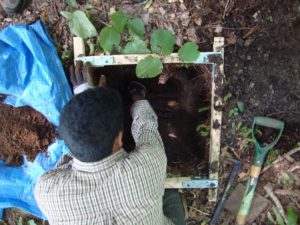
Beginning the excavation of a quantitative soil pit. It is key to make sure the walls are straight and measure rocks that straddle the walls.
There are many other ways to analyze soils without digging a soil pit such as drill-coring and hand augering.
However, there is no better way to get up close and see the different soil horizons as they exist in a landscape than digging a soil pit.
Happy digging!
The Art of the Soil Pit
Excavating a soil pit is to peel back the only layer of the Earth we know, to see what lies beneath. Soil pits are a way of traveling back in time, to see what the soil looked like before plants and time took hold.
However, there are many ways to dig a soil, each with their own advantage and disadvantage.
A typical soil profile (Typic Haplorthod in New Hampshire).
The most basic goal of a soil profile face is to expose the different horizons for analysis. A soil pit allows for determination of a whole spectrum of soil properties: horizon depths, colors, texture, structure, root density, rock fraction, etc… for a soil profile. This is the tried and true method, for amateur soil aficionado to the veteran pedologist. However, this can be very difficult or easy to dig.
Digging an entire soil profile can be tough in soils with high rock content and nearly impossible in soils with strong restricting layers from cementation by clays, carbonates, or silica.
The high rock fraction at the bottom of this soil pit was extremely difficult to dig through!
However, soils that have weak structure, low clay content, and have few tree roots are easy to dig in.
This soil pit was dug by two people in 3 hours because it was very sandy with little structure.
One of the next important things to think about when excavating a soil pit is figuring out how it will be analyzed. Many scientists choose to excavate soil pits based upon predetermined depth intervals. By choosing depth increments rather than by horizons and the innate structure of the soil, scientists often miss the unique features of each horizon. Granted, it is far more easier for calculations at the landscape and global scale to assume soils are homogeneous and use depth intervals. However as shown in the illustration below, important features are missed.
Analyzing a soil pit by depth increments rather than by horizon. Notice how very different horizons can be lumped together.
Lastly, soil pits should be dug based upon their intent. If the goal is to sample a soil profile to bedrock, make sure you dig it wide enough. A general rule is for every foot in depth, it should be one foot wide and one foot in horizontal dimension. If you don’t follow this rough rule, you might end up eating and wearing a lot of soil!
If you don’t make the soil pit big enough, you’ll have to do some acrobatics to collect your samples!
If the ultimate goal of a project is to scale results to the landscape or global scale, then digging quantitative soil pits is the best method. It can adequately assess soil, root, and rock mass in a given volume when done correctly. They can be excavated multiple times on the small scale (15 cm by 15 cm) or a few on a larger scale (50 cm x 50 cm).
Small quantitative soil sampling on shallow soils. Much like cutting a birthday cake!
Beginning the excavation of a quantitative soil pit. It is key to make sure the walls are straight and measure rocks that straddle the walls.
There are many other ways to analyze soils without digging a soil pit such as drill-coring and hand augering.
However, there is no better way to get up close and see the different soil horizons as they exist in a landscape than digging a soil pit.
Happy digging!